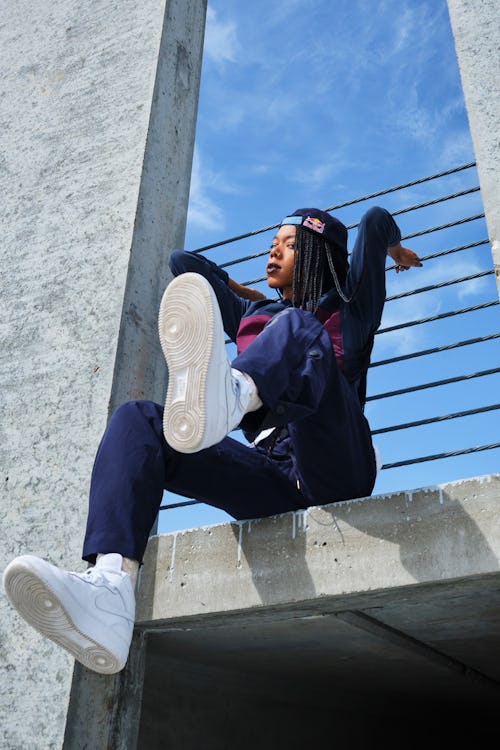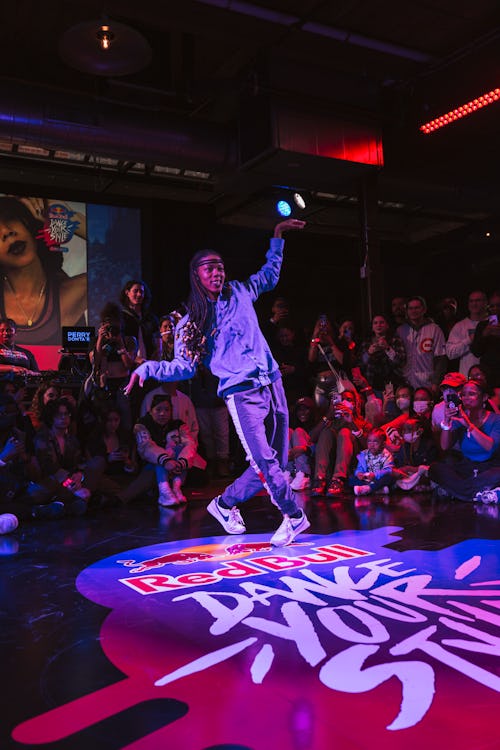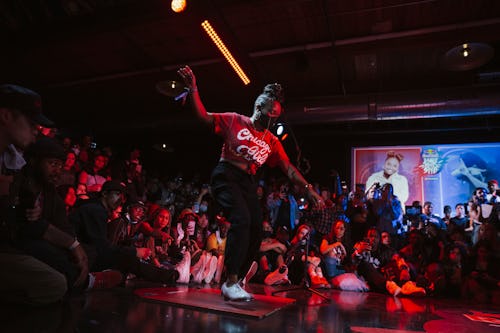
There’s an element of professional dance called musicality that competitors are assessed by. It’s the ability to hear, process, and move to the music you’re dancing to so intuitively that you become a physical expression of the song. It’s almost like being an empath to the beats and melodies; instead of existing alongside them, you jump in, head first. And then you flow through some alternate universe until it’s all over and you’re sweaty and breathless in the best way.
While the binary is most definitely a social construct, the way female street dancers catch the spirit is very telling. They’re just as bold, skilled, and thoughtful in their craft as the men, but their bodies’ stories just hit different. It might be the thread that links them back to customs of movement that date past 1970s Bronx, where breakdancing first became a thing, to West Africa, South America, and various Indigenous communities where women connected to the earth and the sky through dance.
For Angela McNeal, better known in the dance community as Angyil, dance is prayer in physical form. “Depending on which moves I’m doing and what I’m feeling that day, the prayers change,” the 27-year-old Kansas native says. She describes an Instagram post from a day when she was feeling particularly sensitive to the energies around her. “People take advantage of each other’s vulnerability. But also I think that being vulnerable is beautiful. I pray that people would be more vulnerable in social spaces.”
Angyil has won countless dance championships all over the world — besting many of her male peers — and her vulnerability has been key to her success. It seems almost counterintuitive to become softer when facing competition, but it’s clearly worked for her. “I try my best to surrender. Whatever feelings or thoughts I have before I get into a space, I try to surrender that and pay attention to what I’m feeling in the moment,” she says.

When I saw Angyil dance at Red Bull’s Dance Your Style competition in Chicago last month, there was an air of serenity about her; she was a guest, not a competitor, after all. Her movements were short and joyful, her long microbraids floating airborne with every pop. She slid onto the small, shiny dance floor, completely open to the energy her onlookers were giving her. Her performance was like a vibrating, kinetic snowflake — unique, personal, and honest.
Watching the Black and brown women dancers pop, lock, jit, and tap at the event that afternoon gave me a visual understanding of a feeling many of them described to me during interviews: getting to be your most authentic self on the dance floor regardless of what anyone expects from you.
“Dancing is a form of escapism for some of us,” Diamond Hardiman, a 28-year-old dancer from Chicago, tells me. “So it’s about being real and honest, yes. But at the end of the day it’s also about being tough. You know, like, solid. And being free.” For Diamond, the city she was raised in posed complex dichotomies. It’s rich in culture and reverberating with energy, but also isolated in many ways. “Sometimes, you can’t be free in Chicago. There’s bondage of all types here. So when we dance, it’s about freedom,” she says.
Diamond’s lightning-fast footwork will slap anyone awake to the reality of what it means to be a woman artist in 2022. Seeing her face off with a talented male opponent revealed so many realities that exist for her: confidence, curiosity, fear, and joyful expressions of sexuality. Watching her and Angyil, in particular, dance conjured the journey of women rappers like Megan thee Stallion, Cardi B., and Nicki Minaj, with their delicate balance of what we’d consider femininity and masculine bravado. When you teeter at the intersection of identities like that, so much is at stake, but there’s also so much to marvel at.
“When we dance, it’s about freedom.”
The dancers I talk to circle back, organically, to the concept of freedom — getting to tell your story and help other women tell theirs. Dance is an oral tradition, of course, and for them a tool to sustain and build community. For that reason, mentorship has been crucial. As Detroit native Gabby McCleod a.k.a. “Queen Gabby” describes to me, women mentors have been hard to come by, so forging a path for success in the field was challenging. “We didn’t have examples of it, so we have had to go up there and be the example,” she tells me. “I can count on my hand how many women jit. It’s important to push the way I push so we can have more representation.”
Gabby and her peers (all Red Bull athletes, globally lauded for their art) appear keenly aware of where they stand in the professional dancing scene as well as in their social landscape right now. It’s evident from what they told me about centering community and the dangers that can come from straying away from that lighthouse.
“As Black women, there are a lot of people who will want to take advantage of you,” says Infinite “Ivvy” Johnson, a dancer from New York, choosing her words strategically. “They will want to put you in a superior position that’s not your legacy.” Constantly guarding oneself from the entertainment industry’s penchant for commodifying, hypersexualizing, and exploiting Black women has become a skill each dancer has honed, right alongside endurance and flexibility.
Hand-in-hand with prioritizing community comes championing the culture — the actual culture, not the stuff you’re bombarded with on TikTok. While social media overflows with fun dance challenges, the platforms perpetuate a huge cultural appropriation problem. Black creators are the drip, yet they’re seldom compensated or even recognized for it.

“I want people to see me — the 24 of years of blood, sweat, tears, injuries, and heartbreak rejection, all of that,” says Donnetta “Lil Bit” Jackson, a dancer also from Chicago. “And I want tap dance to not be forgotten about. It was the first street dance in America and I feel like it gets counted out every time. I’m finna bring it back.”
Getting schooled on the nuances and genres of street dance (I really only knew about breakdance) was both enlightening and humbling, but there was something familiar about all of it. Lil Bit’s footwork is her legacy, but it’s also an act of self-preservation.
In many ways, it’s what women of color have been doing in some way, shape, or form, for all of history: making sure we’re seen when the world tries to flatten us, our culture, and our experiences. That’s why watching women dancers master musicality on the dance floor feels like a little bit of magic. If becoming the music means amplifying your identity, I, for one, can’t wait for the beat to drop.







